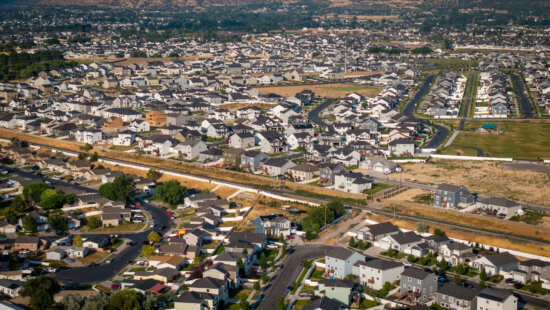News
Family homelessness is a growing problem in Utah. What should be done?

Photo: Unsplash // Ev
Homeless advocates urge preventing evictions, domestic violence and increasing affordable housing for families
By: Katie McKellar, Utah News Dispatch
In 2020, 5,520 Utahns in families were experiencing homelessness, including 2,953 children under the age of 18.
In 2023, that number increased by a striking 27% — up 2,309 individuals to 7,033, including 3,748 children.
That’s according to a January report issued by the Utah Office of Homeless Services depicting the successes and challenges the state’s homeless system saw over the past year.
While grants helped generate 1,069 units of deeply affordable housing and Salt Lake County had a record number of winter overflow beds for the 2023 to 2024 season, totaling 1,210 beds (just to name a few achievements highlighted by the report), Utah’s homeless advocates have been up against some tough headwinds.
Across the U.S. homelessness rates have been increasing due to impacts from the COVID-19 pandemic, housing affordability issues and increased costs of living, the report notes. Meanwhile, Utah’s emergency homeless shelters have been operating at capacity, people suffering from mental illness have been living in shelters and jails, and “the deficit for deeply affordable housing is at 77,000 units.”
“While efforts have been made, additional resources are crucial to address the immediate crisis and allow a shift that will focus more on prevention than emergency response,” the report stated.
In the months since that report was given, the Utah Legislature did act to fund over $50 million toward bolstering and increasing the state’s emergency homeless shelter system, including $25 million toward a new 600- to 800-bed shelter in a yet-to-be announced location, plus nearly $4.5 million for homeless prevention programs and over $11 million for behavioral health.
Though it wasn’t the full $128 million Utah Gov. Spencer Cox initially recommended for three years of support, the governor and his office applauded the funding lawmakers did agree to fund to help fill the gaps outlined in the report.
But low-income and homeless advocates say there’s always more work to do to help — and they’re particularly worried about the growing trend of family homelessness, a population that includes adults with children.
Utah’s growing family homelessness issue
On Wednesday, a group of advocates met on a virtual call hosted by the low-income advocacy group Crossroads Urban Center and the Faith and Advocacy Coalition to End Hunger and Homelessness to specifically discuss the issue of family homelessness and possible solutions.
Heather Hogue, project coordinator with the Mountainland Continuum of Care, a coalition of nonprofit and government agencies in Utah, Wasatch and Summit Counties, highlighted three issues contributing to family homelessness:
- Rising evictions
- Increase of domestic violence rates
- Lack of affordable housing options
“We’re seeing the cost of living in all three of my counties increasing faster than household income,” Hogue said, pointing especially to Summit County, which is the state’s most expensive area and among the nation’s wealthiest counties. “It’s a particular challenge in Summit County for me right now, because the rent is, well, insane.”
The median gross rent of Summit County was $1,822 from 2018 to 2022, according to data from the U.S. Census Bureau. That’s compared to a statewide median of $1,302 in the same timeframe, and a national median of $1,268.
“So when I’ve got eviction prevention funding in my three counties, we’ve got to double or more the cost of paying for someone’s monthly rent for helping (with) eviction prevention in Summit County because that cost of living is so freaking high,” Hogue said.
Domestic violence rates have gone up across the Mountainland Continuum of Care’s three counties, Houge said, contributing to family homelessness across the state. Domestic violence rates rose nationally during the first two years of the pandemic, and Utah followed that trend, according to a March 2023 report from Utah State University’s Utah Women and Leadership Project.
In the Mountainland area, 37.8% of people counted in the 2023 Point in Time Count, which reported annual statewide data on people experiencing homelessness on a single night in January, said they had experienced domestic violence, including adults and children.
“That is a demographic that sort of points to the fact that homelessness may not be what we think,” Hogue said. “We’re seeing a lot of people that are displaced because of domestic violence, and seeing a rise of men who are survivors of domestic violence as well and seeking safety.”
As for a lack of affordable housing options, Hogue noted that in Utah County in particular — home to two universities — college students and families are competing against each other for housing. Because of the limited housing availability, she said landlords are reluctant to accept tenants using housing subsidies, families without income that is three times the monthly rent, or people who have poor credit, eviction records or criminal histories.
“So that makes it a little more difficult for families that we see entering our homeless response system. They’re just competing with these scarce resources,” she said.
Solutions for family homelessness
Hogue also outlined some ideas for solutions. She urged agencies and advocates to focus on:
- Partnering with local organizations (such as housing authorities and domestic violence shelters) to grow the number of housing units reserved specifically for families experiencing homelessness.
- Direct families to “coordinated entry” points within the homeless system to ensure they have the opportunity to get connected with wraparound services and reserve their spot on waiting lists for housing openings.
- Focus on eviction prevention, or keeping families housed rather than having to find a new place to stay. “It is easier, cheaper and more humane to keep somebody housed than it is to rehouse them, especially when we’re talking about children,” Hogue said.
- Advocate for low-income housing tax credits to help increase the stock of affordable and deeply affordable housing.
- Advocate for cities to allow for more medium and higher density housing projects.
Bill Tibbitts, deputy executive director of Crossroads Urban Center, pointed to Switchpoint, an organization that operates homeless facilities in four counties across Utah. He noted Switchpoint is unique “because from the beginning you’ve planned for families.” Their facilities have rooms and spaces reserved specifically for families, and they have child care providers on-site.
Carol Hollowell, executive director of Switchpoint, acknowledged “homeless families are really difficult to serve and place because it requires a lot more space. If you’ve got a single mom with a couple of kids, that’s going to take up a whole room.”
Hollowell noted Switchpoint’s St. George facility is currently under construction to expand its campus. In the past it’s had five family rooms, she said, “and it was never enough. We’ve always been at full capacity.” After expansion is complete, she said the facility will have 16 family rooms, “which is a big deal for us.”
Hollowell said the same problems Hogue described apply to St. George, a rapidly growing city in southern Utah where students and families compete for housing. It’s also a popular retirement and vacation home destination, which compounds the area’s housing availability and costs.
“Because of that, Switchpoint has taken on one of our top focus priorities to create attainable and affordable housing,” Hollowell said.
But it’s not just Utah’s more expensive areas that are facing challenges with housing and family homelessness. Hollowell also pointed to Tooele County — a mostly rural area to the west of the Wasatch Front — that’s one of Utah’s more affordable areas.
“But there’s just no (housing) availability,” Hollowell said.
In November, Switchpoint opened a new homeless resource center campus called Harris Community Village that includes a 44-bed shelter with seven family rooms, as well as 66 housing units with on-site child care.
Hollowell said many families experiencing homelessness in Tooele County were living in their cars or camping in nearby canyons. “They could not afford to be anywhere, even in Tooele County,” she said.
Hollwell floated several ideas to address family homelessness, including:
- Working with developers to convert or develop with a variety of partners to create more family housing units.
- Expanding access to affordable child care available 24/7, especially for working families that may work night shifts.
- Help families experiencing homelessness develop skills to obtain work and gain self reliance.
Rep. Tyler Clancy, R-Provo, also joined Wednesday’s discussion. Clancy sponsored homelessness related legislation during the 2024 session, including HB298, which restructured the current Utah Homelessness Council to become the Utah Homelessness Services Board and requires the state and local homelessness councils to establish specific goals around homelessness.
Clancy noted that Tibbitts brought the issue of family homelessness to lawmakers’ attention, and provided specific language to include in HB298 to “make sure we are looking specifically at family homelessness. The bill specifies that “family homelessness” is a type of homelessness that state and local homeless councils must track as part of their “functional zero” goals for addressing homelessness (meaning the number of people exiting homelessness is greater than those entering).
Clancy said family homelessness can create “long term challenges” for Utah kids, from economic stability, education, health care and more.
“It’s an important issue,” Clancy said, adding that he was participating to “listen and learn about how (lawmakers) can help.”



















